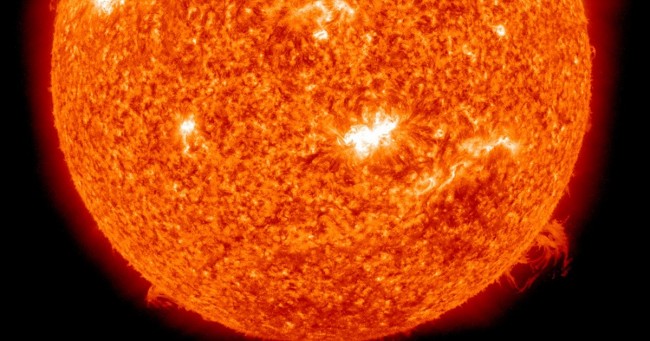A solar storm is forecast to hit Earth after the sun unleashed a powerful solar flare — a burst of high-energy radiation — Sunday night.
An intense coronal mass ejection on the surface of the sun is now sending millions of supercharged particles to slam into Earth.
The so-called geomagnetic storm was responsible for last night’s dazzling Northern Lights, but its impact could be more far reaching than the eye-candy Aurora Borealis.
As the charged particles break into Earth’s natural magnetic field and atmosphere, scientists have warned of potential disruptions to power grids, communication satellites and aircraft.
According to the latest alert from NOAA’s US-based Space Weather Prediction Centre (SWPC), the storm is relatively weak but still poses danger.
The SWPC warned: “Potential Impacts: Area of impact primarily poleward of 65 degrees Geomagnetic Latitude.
“Induced Currents – Weak power grid fluctuations can occur.”
Solar storms have been known to cause sever power blackouts in the past.
Infamously on March 13, 1989 the entire Canadian province of Quebec suffered a major power outage.
The tech blackout was caused by a gigantic eruption of solar energy just three days prior, on March 10.
The eruption unleashed the energy of a “thousand nuclear bombs exploding at the same time”, according to NASA.
The America space agency said: “The storm cloud rushed out from the sun, straight towards Earth, at a million miles an hour.
“The solar flare that accompanied the outburst immediately caused short-wave radio interference, including the jamming of radio signals from Radio Free Europe into Russia.
“It was thought that the signals had been jammed by the Kremlin, but it was only the sun acting up!”
As well as power grid fluctuations, NOAA expects minor satellite interference today.
NASA has also said even weaker storms like this have been known to befuddle animals and mess with their internal compass.
Aeroplanes are also at risk of interference to their onboard apparatus, as well as exposing fight crew and passengers to increased levels of radiation.
NASA said: “Today, airlines fly over 7,500 polar routes per year.
“These routes take aircraft to latitudes where satellite communication cannot be used, and flight crews must rely instead on high-frequency (HF) radio to maintain communication with air traffic control, as required by federal regulation.
“During certain space weather events, solar energetic particles spiral down geomagnetic field lines in the polar regions, where they increase the density of ionised gas, which in turn affects the propagation of radio waves and can result in radio blackouts.”
Fortunately for Earth, the planet is mostly shielded from the harmful storm by its magnetic field and atmosphere.
This year solar flares are also expected to be less active than in the past, due to the sun’s 11-year cycle of sunspot activity.
The sun last reached its peak maximum of coronal ejections in 2014 and is now slowly fading out until the cycle resets.















